991 Suspension Overview, The 7th Generation Of The Porsche 911
Here it is, the 7th generation Porsche 911, factory codenamed the 991. This car was introduced in 2012 to replace the 997 and features some extensive redesigning of the chassis, suspension, motor and pretty much everything else.
The 991 has a striking physique. It looks fast even on the lift! And while it’s here, let’s see what making this car handle as good as it does.

Porsche has a lot of options and variant for the 991series. Many of those options affect the suspension equipment and so this car is not representative of the entire 991 line.
This car has the following suspension related options:
- US Spec C2S
- PASM
- PDCC
- Factory Wheel Spacers

The front suspension is very similar to what we find in the 996s and 997s, a Macpherson strut setup that features two lower control arms. Porsche has been using Macpherson strut front suspension since the inception of 911s in 1965. It’s a simple, lightweight system that’s proven to work well on the front of the 911 series.

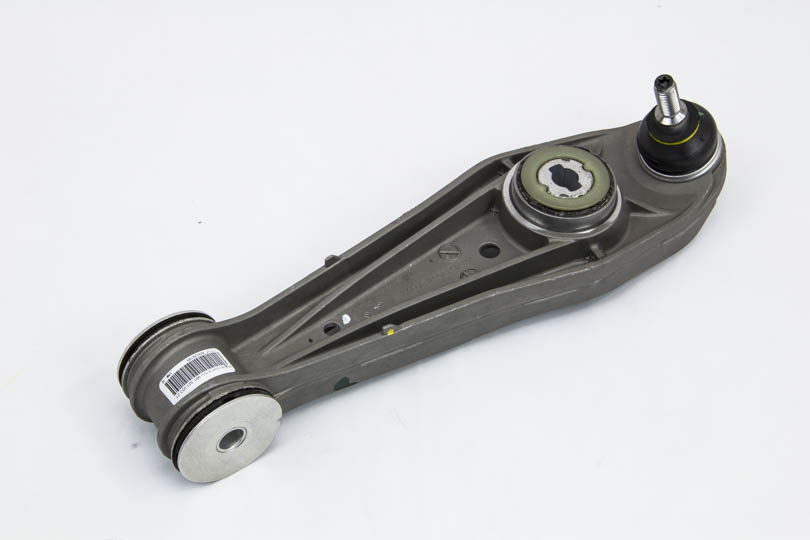
Although the new lower control arm is marked with a new 991 part number, it has not changed much from the previous generation; in fact the center bushing retains 997 markings.
Just as with the 997 lower control arm, the center and inner bushings are rubber. The center bushing is reinforced with a plastic insert as pictured above. The inner bushing is sandwiched between two metal washers.
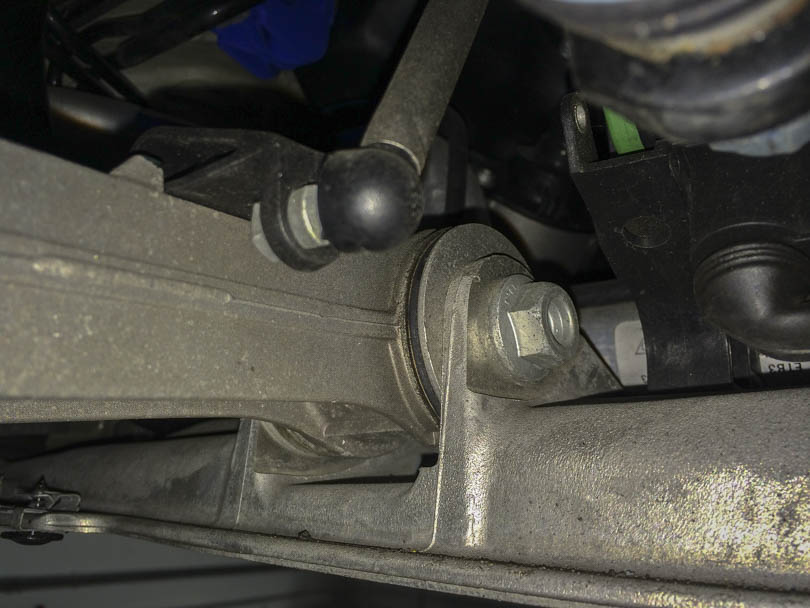
Inner bushings bolt onto the front subframe with a single bolt in double shear.
Unlike the GT3 counterpart, which has length adjustable arms, this lower control arm is fixed length and has no provision for camber adjustment.
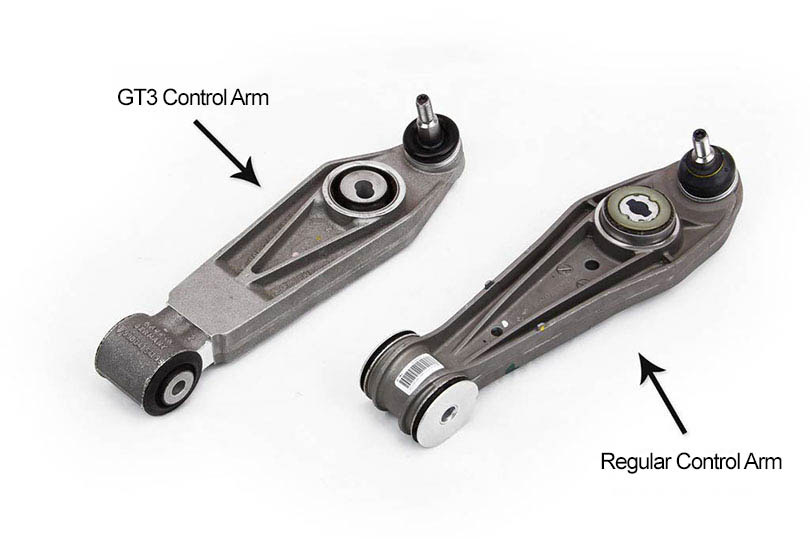

Looking further underneath, you’ll notice the odd shaped sway bar drop link. This car is equipped with PDCC system, which stands for Porsche Dynamic Chassis Control. PDCC system dynamically controls the roll of the car by hydraulically changing the drop link length at each wheel.
The front drop link has a length adjustment range of about 50mm. Increasing the length of the drop link on the outside wheel while decreasing length on the inside wheel while cornering applies a pre-load to the swaybar. This creates a weight jacking effect, or ‘wedge’ which changes the under and oversteer tendency.
Static weight jacking has long been used to great effect by circle track racers for optimizing left turns. This system controls the weight jacking dynamically for both left and right turns. It manages lateral roll and tendency to over and under steer.
991 is the first generation of 911 cars to feature this system. Similar system was used in the Cayenne models for many years.

The hydraulic PDCC drop links are much longer than the non-PDCC type. To accommodate the extra length mounting brackets are used to clamp the top of the drop link to the strut body. Non-PDCC cars do not have these brackets.

Regular drop links are shorter (as pictured above) and bolt directly onto the wheel upright. Regular drop links are very similar to ones found on 996/997 cars.
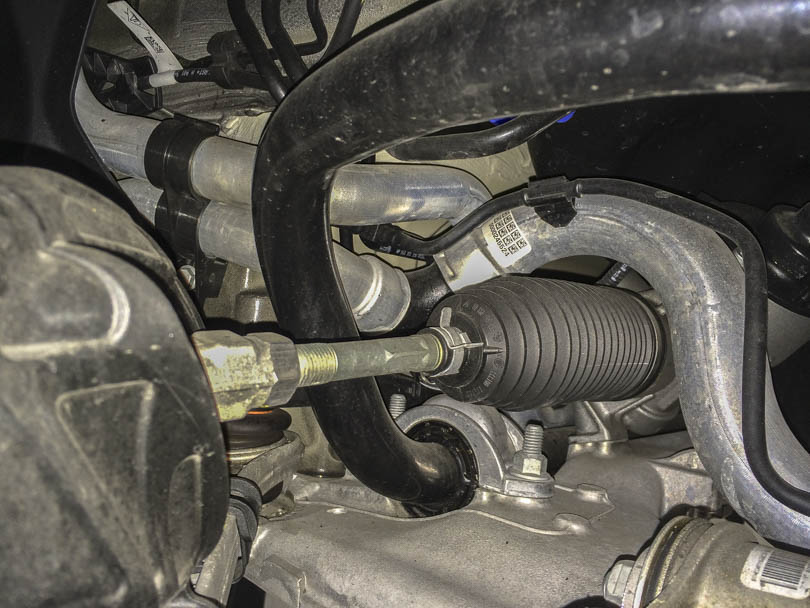
The swaybar itself is mounted directly to the lower subframe just as it was on the 996/997 cars, and wraps above the inner tie rod and the control arm. We’ve measure this bar to be 31mm thick and is similar to the bar found on C4 cars that have a front axle. The bar is hollow to reduce weight.
The swaybar bushings are also reinforced with a layer of metal. This makes the bushing firmer while retaining noise and vibration isolation characteristics.
The front swaybar is large. Mounted ahead of the lower control arm in front of the steering rack, it arches up over the lower control arm to attach the drop link behind the wheel upright. This creates a long moment arm and is the reason the bar is so thick.
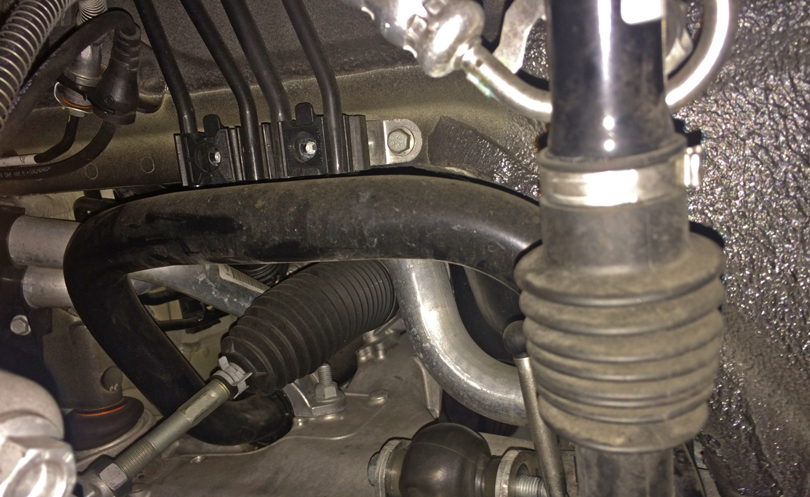

As with the 997, the spring is concentric on the strut. The strut is clamped onto the wheel upright. This is a coilover setup but has no provision for height adjustment or corner balancing.

We’ve tested the spring rate and calculated it to be at 187lb/in and is linear, which is about the same as 997 Carrera S spring rate (188lb/in).
The strut is made by Bilstein and is a twin tube design. This car is equipped with PASM.

As was equipped on the 996/997 cars, both the upper spring perch and strut mount bushings are rubber. The spring seat rests on the chassis and includes a bearing to relax spring windup from steering angle.
Unlike previous generations that were formed sheet metal, the chassis has a cast metal area for the upper strut mount and spring perch to rest against. The cast area is gusseted and appears to be very sturdy. The upper spring perch mounts in slotted holes in the cast metal to allow camber adjustment. We measured the stock static negative camber at 1.3 degrees, which is pretty healthy for street, but limited for track use. We maxed out the stock range of adjustment at 1.8 degrees.

On the top of the camber plate we can see the PASM cable sticking out of the shock rod. PASM stands for Porsche Active Suspension Management. Similarly to PDCC system, PASM dynamically controls the damper valving. According to Porsche, this system continuously adjusts the damping force based on road conditions and driving style. Additionally Porsche states the PASM suspension is 20mm lower than standard non-PASM cars.
There are two modes to choose from, normal and Sport. Sport mode will valve the shock more aggressively, while the normal mode allows for a more comfortable ride. The difference between the two modes is not as extreme as in the 997 PASM, but it is noticeable. In contrast we’ve had much harder time distinguishing from the two modes in the 991 GT3.

Caster arm and tie rod also remain unchanged from the 996 and 997 generation. Although they both received new part numbers, they seem identical to 997 parts.

And also just like with the 996/997s, the caster arm features a spherical bearing. Sadly the caster still remains non-adjustable.

The tie rod is length adjustable for toe alignment. We measured stock toe at zero (0) degrees.

The biggest difference noticeable is the redesigned wheel carrier and new front subframe. Both are cast aluminum and presumably lighter than it’s predecessor.
We’ve also made an observation that all of the bolt heads have been bored. The only reason we can think of is to save weight.

This car has the optional ceramic disc brakes which are less than half the weight of regular iron rotors. Reduced rotational mass improves acceleration and braking.
The front rotors are massive at 350mm with six piston brake calipers, just 30mm shy of the 991 GT3 rotors. That’s some serious stopping power.
We found the brakes to be very responsive, even when cold. The brake booster seems almost over-eager and requires little pedal effort.

The brakes are cooled by drawing the air from underneath the car and the front bumper. Air is diverted towards the discs by using a shield that is strapped onto the caster arm.

Also present is an optional 5mm factory spacer. The spacers add subtle but noticeable stance improvement.
Rear Suspension
Let’s move onto the rear. Here’s where most of the new suspension innovation has taken place.
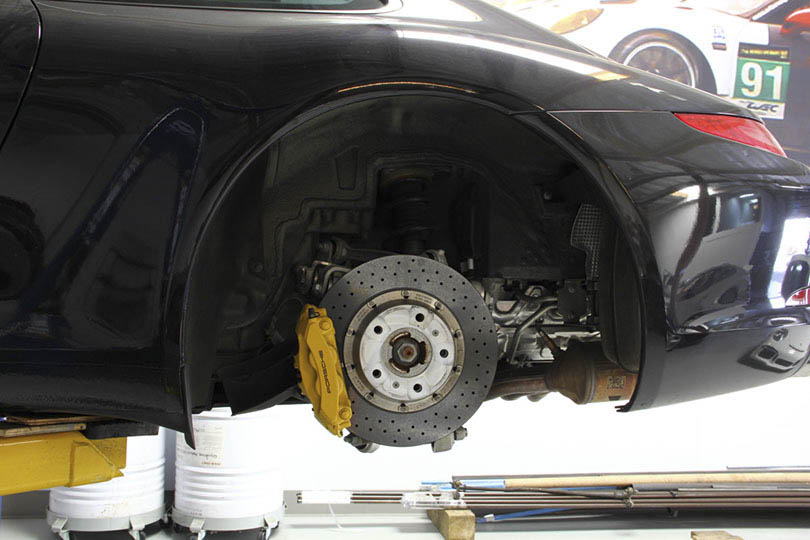

Like the 996/997 generation, multi-link suspension is used in the rear, however, the suspension has been completely redesigned from the ground up.
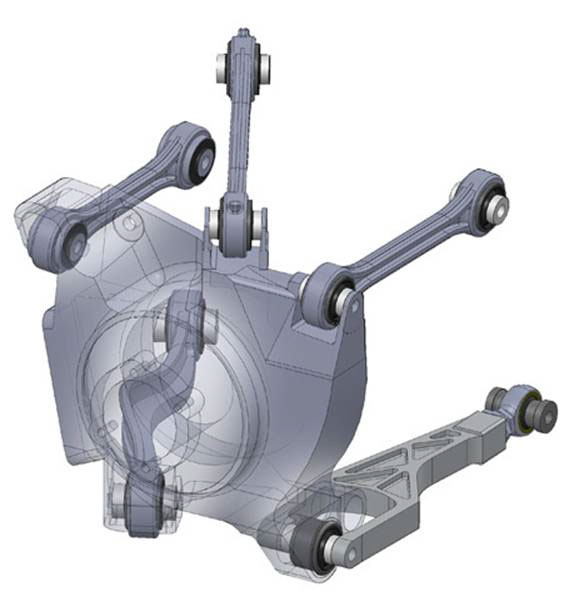
All new rear wheel carrier and subframe support two upper control arms,two lower control arms and a toe link.
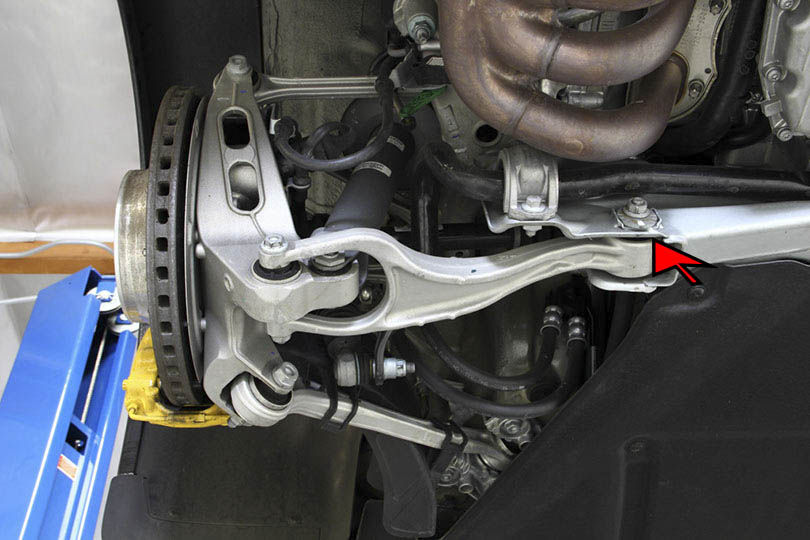
The lower wishbone is strikingly different from previous generations, which looked identical to the front coffin shaped control arm. The ball joint has been replaced in favor of a bushing that is pressed into the wheel upright. The lower control arm is attached to the bushings at both the inner and outer ends in a double-shear bolt arrangement. This is very strong and eliminates the ball joint single-shear stud used in the 997.
The wishbone fork wraps around the rear shock mount. This allows a bit of extra length in the shock. The eccentric bolt (red arrow) at the inner bushing is used for camber adjustment. We measured the stock camber at 2 degrees negative. But we were able to max out the camber at 2.6 degrees which is pretty impressive for a stock car.

The other lower control arm has an “S” shape. The reason for the S shape is not clear as there does not appear to be any interference issues. The 911 GT3 and Cup cars have a straight member in this location.

The rear shock also is mounted on a rubber bushing that is pressed into the wheel carrier. Note that both of the bushings are reinforced.
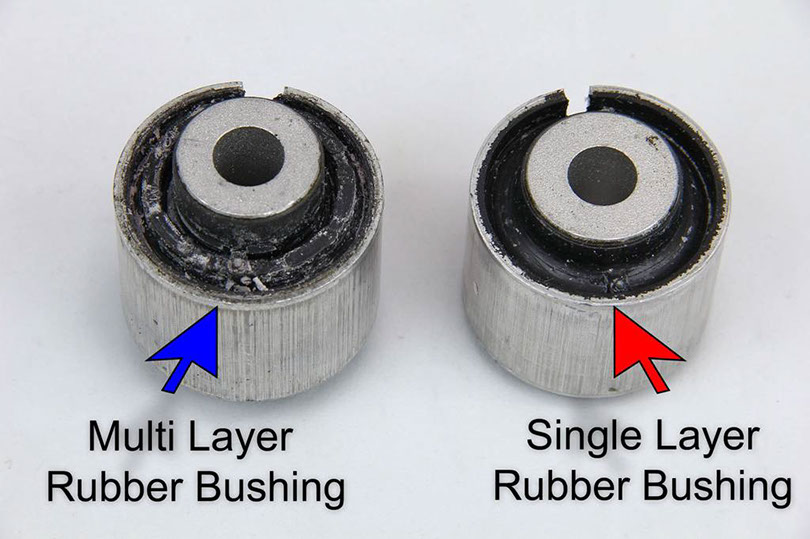
There are two kinds of bushings on the 991 cars, one (red arrow) is composed of a single layer of rubber, while the other is composed of multiple layers. The multi-layer bushing has an additional solid metal layer inserted between two layers of rubber. Harder bushings are more resistant to deflection and compression under heavy cornering loads and hold alignment better.
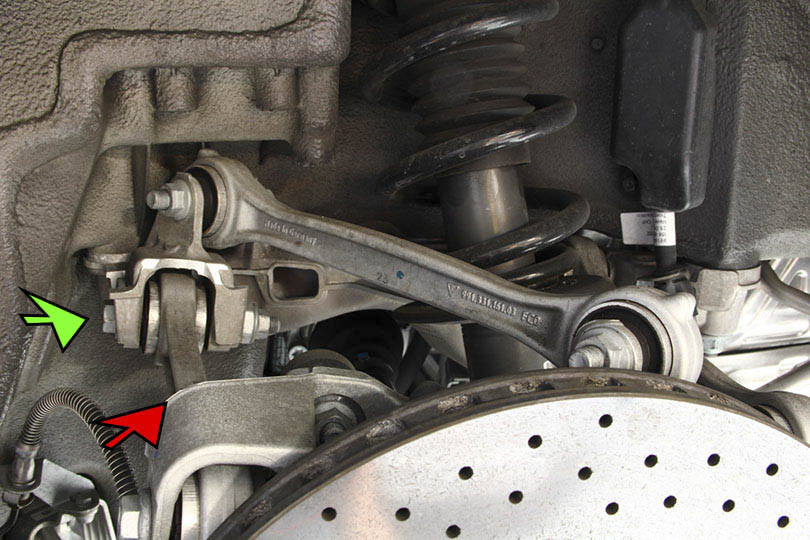
Moving to the top, the arm on the left (red arrow) is responsible for the toe adjustment. There is an eccentric adjuster located at the inner bushing mount to set the toe (green arrow).
The toe arm sports the ridged multi-layer bushing, while the upper control arm next to has softer, single layer bushings.

The second upper control arm also features reinforced bushings. Neither of the upper control arms have any provision for length adjustment, they are fixed length. The only adjustments are the toe link eccentric and the camber eccentric at the lower control arm.
note that the height sensor is attached to this arm. The height sensor is used for the headlight alignment, PASM and PDCC system. There are 4 height sensors total, one for each wheel.
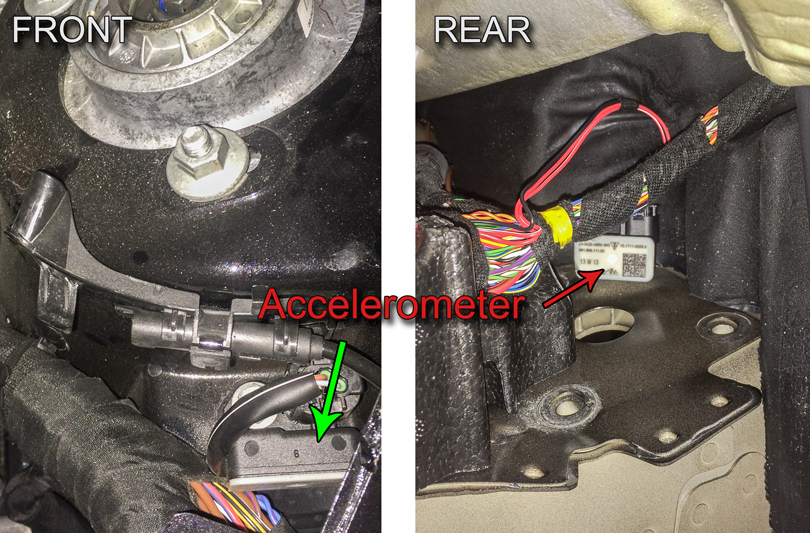
There are also accelerometers fitted by the shock and strut mounts. We’ve found 2 accelerometers in front and one in the back behind the driver side shock mount, apparently to sense vertical acceleration. Why only three sensors and not four? Because Three points define acceleration of the plane. So three points provide enough information to derive acceleration of all points of a plane through the chassis. Presumably these are similarly used in the algorithms for the PASM and PDCC systems.

Subframe has also received a quite extensive redesign. Where the crossmember was aluminum casting, the new crossmember is formed out of stamped sheet metal. The crossmember supports the inner lower control arm bushings and the swaybar. On the 997, the control arm was supported on the side subframe.

Rear subframe is further supported by steel diagonal members bolted in place. These diagonal members help locate the rear crossmember under cornering loads.

We’ve measured the rear sway bar to be 29mm thick, and it too is hollow for weight savings. The sway bar bushings are reinforced with a metal layer.

Similar to the front, rear drop link is also a hydraulic cylinder, although shorter. It’s a part of the PDCC system as described earlier. The drop link mounts directly to the top of the wheel carrier. We’ve measured the drop link range of travel to be 55mm, about 5mm more than the front.
The PDCC actuators are built into the drop links on both the left and right sides of the car.
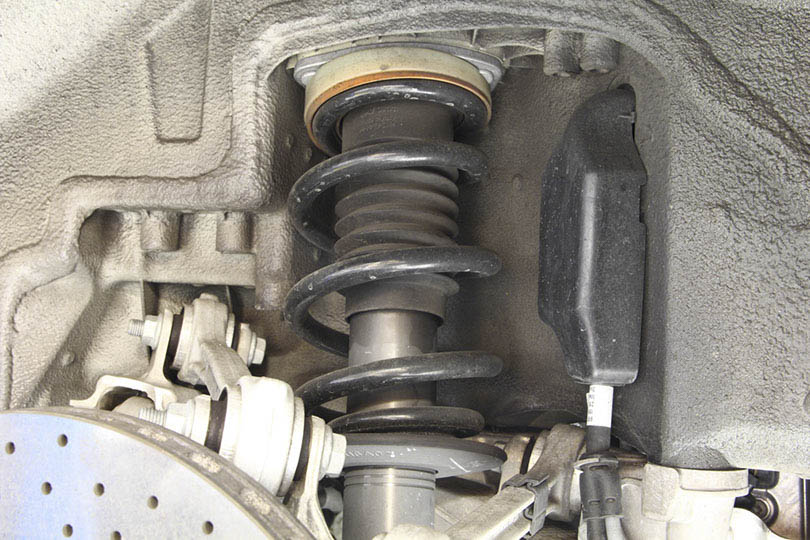

The rear spring also coils over the shock just like in the front. We’ve measured the spring rate as mildly progressive and about 350 lb/in.
The rear shocks are a monotube design and are provided by Bilstein.
Just like the front, the upper spring perch and shock mount bushings are rubber.
Similar to what we saw on the front, the mounting pad on the chassis is a cast steel part with reinforcing gussets that is welded to the chassis sheet metal. This is departure from the 997 all-sheetmetal solution and is very sturdy looking.

Another interesting thing to note is that the rear shock lower perch is supported by a snap ring that fits in a groove machined into the shock body. There are multiple snap ring positions to lower or raise the lower spring perch giving the rear a little bit of height adjustment range.

The rear rotor is also 350mm and is coupled with a four piston caliper.
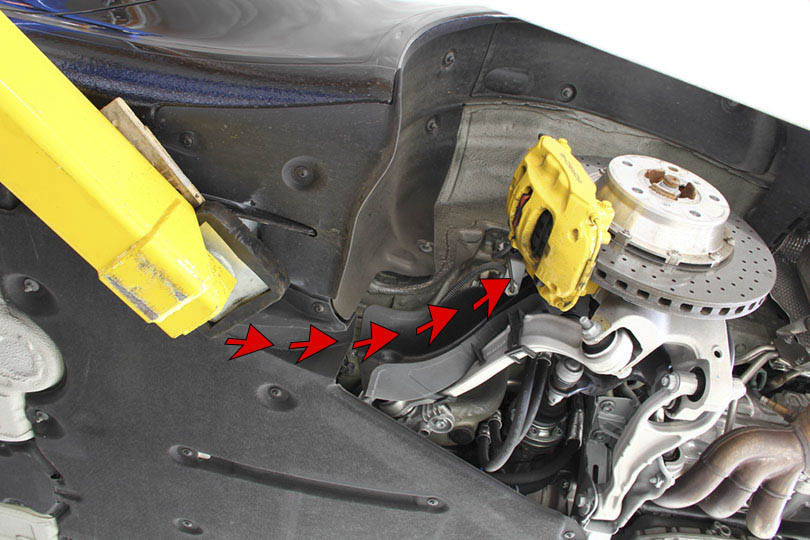
Cooling of the brakes is also done via ducting work. Air is being drawn from underneath the car and deflected towards the caliper and the rotor. The duct shield is strapped directly onto the s-shaped lower control arm.

And just like in the front, we find a 5mm factory wheel spacer.
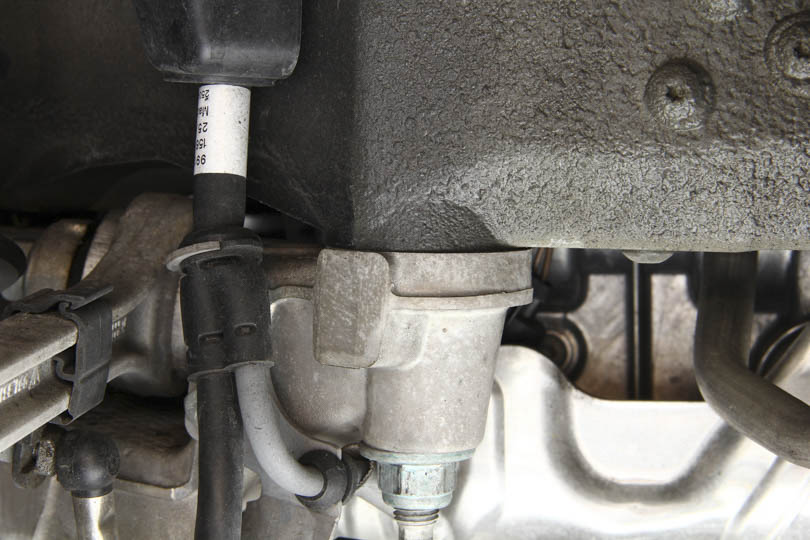
Another interesting change to note is the solid subframe mounts. Both 996 and 997 cars had rubber bushings between the chassis and subframe. 991 cars are now completely solid, just like the GT3 and Cup cars. Eliminating rubber in this position prevents the subframe from shifting due to rubber deflection while cornering or hard braking.
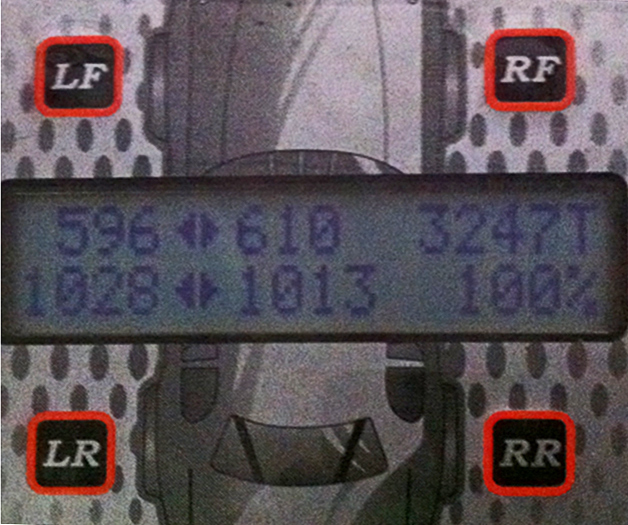
The Total weight of the car is 3247 lb, that’s with half a tank of fuel. Please note that this car is equipped with ceramic brakes and lightweight 20in wheels.
The corner balance is 50.4% which is very good for stock/factory car.
This concludes the walk-around, for GT3 comparison please check out our 991 GT3 suspension walk-around.


















